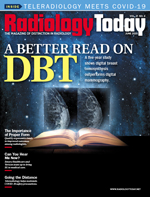 Interventional News: COVID-19 and the Interventional Radiologist
Interventional News: COVID-19 and the Interventional Radiologist
By Lavi Nissim, MD
Radiology Today
Vol. 21 No. 6 P. 26
On March 11, 2020, the World Health Organization declared COVID-19 a global pandemic.1 The emerging infectious disease manifests in some cases with acute respiratory distress from severe viral pneumonia, leading to multiorgan failure. The rate of mortality is uncertain at the time of this writing, but conservative estimates assume a magnitude 10 times that of seasonal influenza.2 In the months since cases were initially reported in the Hubei province of China in December 2019, there have been more than 3 million diagnosed cases globally, resulting in hundreds of thousands of deaths.3 The rapid spread of the virus and ensuing stress on health care systems across the globe has resulted in significant socioeconomic impact and unprecedented government-enforced measures to control the pandemic, including social distancing regulations, broad-sweeping business closures, pervasive use of personal protective equipment, and regional shifts in allocation of health care from nonemergent to emergent.4
Expanding Repertoire
To the interventional radiologist, the COVID-19 pandemic presents a unique set of both challenges and opportunities. With many state and local public health declarations calling for restrictions on elective surgical procedures, hospital-based IR practices in the United States will likely see a short-term reduction in elective case volume, while outpatient IR practices may see significant constraints for the duration of the pandemic.4
Furthermore, guidelines on quarantining after a positive diagnosis of COVID-19 may drastically encumber an IR practice in a small community hospital or small outpatient practice, should one or more of the IR physicians test positive for the novel coronavirus or become diseased.4 IR physicians are at an increased risk of exposure to the virus, given the multitude of hands-on procedures and physical evaluations involving close patient interaction that they perform daily. IR physicians may have direct exposure to patients sickened with the disease, as procedures such as venous access or thoracentesis may be required in the treatment of patients with COVID-19 pneumonia. Shortages in the national supply of personal protective equipment, such as N95 masks, further place limitations on IR practices and their ability to perform procedures with adequate staffing in the procedural room.5
While the duration of the COVID-19 pandemic is, at this time, unknown, it does present some opportunities for long-term growth in the IR world. Reductions in hospital staffing, in an effort to enforce social distancing, as well as enforcement of quarantine guidelines for physicians who are diagnosed with COVID-19, may require the IR physician to play a greater role in inpatient procedures routinely performed by other specialties such as cardiology and general surgery.
In addition, IR physicians should take it upon themselves to help alleviate the strain on other specialties burdened by demands on the system, such as by participating in critical venous and arterial access procedures in the emergency department (ED) or ICU or performing thoracentesis or chest tube placement to treat COVID-19 patients with pleural effusion. Depending on level of comfort and degree of urgency, the IR physician may even attain temporary privileges to assist in other procedures not typically ascribed to the specialty, eg, endotracheal intubation, rounding on ICU patients, or assisting with ED overflow. Trainees graduating from the newer IR residency programs with integrated ICU rotations may be more adept at these adaptations than their traditional predecessors.6
The COVID-19 pandemic, like others before it, will eventually pass, and the consortium of scientists, health care professionals, and governments around the world working tirelessly and expediently to combat this new scourge will be victorious. Now is an opportune time for IR physicians to acquaint themselves with the unique challenges the pandemic presents to their specialty and embrace a call to rise to these challenges with their varied expertise.
— Lavi Nissim, MD, is a radiologist in the department of radiology at Phoenix Children’s Hospital in Arizona.
References
1. World Health Organization. WHO director-general’s opening remarks at the media briefing on COVID-19 — 11 March 2020. https://www.who.int/dg/speeches/detail/who-director-general-s-opening-remarks-at-the-media-briefing-on-covid-19---11-march-2020. Published March 11, 2020. Accessed March 11, 2020.
2. Fauci AS, Lane HC, Redfield RR. COVID-19 — navigating the uncharted. N Engl J Med. 2020;382(13):1268-1269.
3. Coronavirus resource center. Johns Hopkins University & Medicine website. https://coronavirus.jhu.edu/. Accessed April 1, 2020.
4. Gostin LO, Hodge JG Jr. US emergency legal responses to novel coronavirus: balancing public health and civil liberties. JAMA. 2020;323(12):1131-1132.
5. Centers for Disease Control and Prevention. Strategies to optimize the supply of PPE and equipment. https://www.cdc.gov/coronavirus/2019-ncov/hcp/healthcare-supply-ppe-index.html. Updated April 22, 2020.
6. Kaufman JA. The interventional radiology/diagnostic radiology certificate and interventional radiology residency. Radiology. 2014;273(2):318-321.

